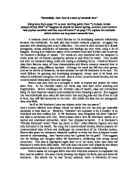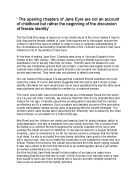This idea is reinforced throughout the novel, especially when it comes to religion. Bronte makes the character of Jane Eyre stand up for her beliefs by challenge the views of men. She uses this character to challenge different ideas about religion. Mr Brocklehurst, the headmaster of Lowood Institution (her second home), represents the hypocrisy in the Evangelical Movement and the forceful authority of men. When referring to his students, he feels the need “not to accustom them to habits of luxury and indulgence,” but to encourage “spiritual edification to the pupils” by making them suffer “temporary privation,” contradicting his own luxurious lifestyle. Jane emphasises the ridiculous in his portrayal and his concepts on religion are mocked through the depiction of his hypocritical sermons, suggesting that this interpretation of Christianity must not be taken seriously. Brocklehurst fails to influence the beliefs of Jane, and in some ways, her friend Helen Burns. This character conveys a different concept: one of endurance and peace mainly based on the New Testament idea of “loving those who hate you.” Once again, Jane is not satisfied with this interpretation of religion and insists that she should “resist those who punish me unjustly.” The third interpretation of religion is represented by St John Rivers, who believes in sacrificing emotional needs for Christianity, which Jane also rejects (by rejecting his proposal). Bronte makes Jane Eyre reject the ideas imposed by male characters, emphasising her controversialist personality. Jane forms a more reasonable and agreeable interpretation of religion than male characters, and Helen in not influenced by Mr Brocklehurst’s cruelty. Bronte proposes another interpretation through this character: that religion does not require you to deny yourself completely; that it can be used as a guide in circumstances beyond human control. By doing this, Bronte shows that females have the ability to form their own opinions on complex ideas, such as religion and that they can form them independently even under the pressure of forceful authority.
The idea that woman are capable of being independent is established when she opposes Mr Rochester’s efforts to “make the world acknowledge you a beauty” by pointing out that she will not be herself if he succeeds, “but an ape in a harlequin’s jacket.” Here Jane is refusing to be objectified and changed even by the man she loves. Bronte presents an independent woman who is sure of herself, and who wants to retain her individuality at any cost. Although Jane is a governess, she makes it clear that Mr Rochester doesn’t “have a right to command” her and that she is equal to him in many ways. Also, Jane maintains her dignity by refusing to marry Mr Rochester. Bronte shows that women are capable of being respectable and that they are not always lead by their emotions. This causes Jane to take courage and leave Mr Rochester, disregarding the Victorian idea that women should do as men wish. While it could be argued that Jane surrenders to the Victorian expectations by returning to Mr Rochester, it is clear that she is not returning to him because she cannot survive on her own. Circumstances change, making Jane rich. She returns to Mr Rochester as an equal in every way (whereas previously she was aware of their social difference), and she returns for love more than anything else.
Besides Jane, Bronte uses the characters of Miss Temple and Diana and Mary Rivers to portray that women are not inferior to men. The mentioned characters influence Jane and are involved in the development of her character as an “independent woman,” as she calls herself by the end. Miss Temple is her role model and helps her to realise that she does not have to give in to forced authority; that she must stand up for what is right. In many ways, Miss Temple gives Jane courage for the future. She goes against Mr Brocklehurst’s orders and sympathises with the girls who are treated cruelly. Apart from feeling differently to him, she takes action by giving the girls “a lunch, consisting of bread and cheese, twice” and fearlessly takes responsibility for it. She is also used represent what Bronte believes to be the true interpretation of Christianity, mainly by giving her a strong sense of injustice in the running of Lowood Institution. While Miss Temple inspires Jane to become independent and to be just, Mary and Diana Rivers inspire Jane to improve her knowledge and to become more intelligent. Jane “followed in the path of knowledge they had trodden before me,” suggesting that she wants to become as knowledgeable and accomplished. The fact that Bronte chooses Jane to be inspired by female characters reinforces the points that women can be intelligent and independent, and at the same time inspire others to become better people.
While some characters are used to represent what women should be, Bronte creates a sharp contrast between the character of Jane Eyre and other female characters in the novel to challenge Victorian the concept of the conventional woman. Women of that time were only valued for their appearance, social and economic status. In many ways, Blanche Ingram (the woman whom Jane believed Mr Rochester loved) represents the ideal woman of the Victorian era. She is beautiful, wealthy and had a well reputed family, contrasting with Jane, who is (in her own words) “poor, obscure, plain, and little.” However, while the Victorian reader might be inclined to admire Blanche more than Jane, Jane feels that “Miss Ingram…was too inferior to excite the feeling” of jealousy because “she had a fine person” but “she was not genuine…her mind was poor.” The modern reader can spot that Jane, in contrast to Blanche is very intelligent, she has self worth and that she speaks her mind. Jane can also analyse one’s character rather accurately, (as proved by Blanches’ rejection of Mr Rochester after she learns of his inferior economic status). Bronte is stressing that women must be admired for their character rather than their outward beauty; that appearances can deceive and that women are worth more than social or economic status. Another contrast is formed between Jane and Bessie, the maid at Gateshead. While Jane rebels against the cruelty of her aunt, Bessie advices her to “make yourself agreeable to them.” Bessie is used to represent Victorian women who give in to the expectations, while Jane represents the idea that women can express their views and stand up for themselves. While some may argue that Jane is a rebellious character, it is clear that she has control of her emotions, unlike Bertha, who lets her rage out (even though it is beyond her control).
By using the character of Jane Eyre, Bronte presents a woman who is capable of being intelligent, independent, dignified and confident about her opinions even though she is not very attractive or wealthy. She uses this character to challenge some of the Victorian concepts concerning women and their positions, as well as to convey her less major themes about religion and class. In some passages, Bronte addresses these issues directly (in the conversation about Mr Rochester and Jane being equals) while she uses more subtle methods in other situations (while describing Blanche). Bronte takes care not to make Jane a perfect person, but she incorporates flaws to allow readers to relate to her. She also uses other female characters to reinforce her points, by showing the qualities of some as well as showing the flaws in others. By doing so, Bronte shows that women can be equal to men, not only in intelligence, but in actions as well. She also portrays different types of women: some who give in to the expectations of society, and some who stand up for their own beliefs. She outlines what she thinks a woman’s qualities should be and she encourages women to stand up their rights. Bronte successfully puts forward her points and she makes the reader understand her ideas by the portrayal of her characters, mainly females.







